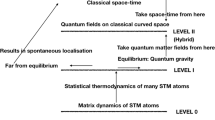Abstract
I propose an experiment that may be performed, with present low temperature and cryogenic technology, to reveal Wheeler’s quantum foam. It involves coupling an optical photon’s momentum to the center of mass motion of a macroscopic transparent block with parameters such that the latter is displaced in space by approximately a Planck length. I argue that such displacement is sensitive to quantum foam and will react back on the photon’s probability of transiting the block. This might allow determination of the precise scale at which quantum fluctuations of space–time become large, and so differentiate between the brane-world and the traditional scenarios of spacetime.

Similar content being viewed by others
References
Bekenstein, J.D.: Is a tabletop search for Planck scale signals feasible? Phys. Rev. D 86, 124040 (2012)
Jacobson, T., Liberati, S., Mattingly, D.: Lorentz violation at high energy: concepts, phenomena, and astrophysical constraints. Ann. Phys. 321, 150 (2006)
Abdo, A., Ackermann, M., Ajello, M., et al.: A limit on the variation of the speed of light arising from quantum gravity effects. Nature 462, 331 (2009)
Mureika, J., Nicolini, P., Spallucci, E.: Could any black holes be produced at the LHC? Phys. Rev. D 85, 106007 (2012)
Randall, L., Sundrum, R.: An alternative to compactification. Phys. Rev. Lett. 83, 4690 (1999)
Dvali, G., Gabadadze, G., Porrati, M.: On sub-millimeter forces from extra dimensions. Mod. Phys. Lett. A 15, 1717 (2000)
Zwiebach, B.: First Course in String Theory, pp. 54–57. Cambridge University Press, Cambridge (2004)
Ali, A.F., Das, S., Vagenas, E.C.: Proposal for testing quantum gravity in the lab. Phys. Rev. D 84, 044013 (2011)
Pikovski, I., Vanner, M.R., Aspelmeyer, M., Kim, M., Brukner, C.: Probing Planck-scale physics with quantum optics. Nat. Phys. 8, 393 (2012)
Hogan, C.: Interferometers as probes of Planckian quantum geometry. Phys. Rev. D 85, 064007 (2012)
Faddeev, L.D.: New dynamical variables in Einstein’s theory of gravity. Theor. Math. Phys. 166, 279 (2011)
Ambjorn, J., Jurkiewicz, J., Loll, R.: Reconstructing the universe. Phys. Rev. D 72, 064014 (2005)
Horava, P.: Quantum gravity at a Lifshitz point. Phys. Rev. D 79, 084008 (2009)
Wheeler, J.A.: Geometrodynamics. Academic Press, New York (1962)
Abraham, M.: Zur Elektrodynamik bewegter Körper. Rendiconti del Circolo Matematico di Palermo 28, 1 (1909)
Landau, L.D., Lifshitz, E.M.: Electrodynamics of Continuous Media. Pergamon, Oxford (1984)
Frisch, O.R.: Take a photon. Contemp. Phys. 7, 45 (1965)
Barnett, S.M.: Resolution of the Abraham–Minkowski dilemma. Phys. Rev. Lett. 104, 070401 (2010)
Acknowledgments
I thank the participants of the “Horizons of Quantum Physics” workshop in Taipei, in particular Wei-Tou Ni, Lajos Djosi and Thomas Jennewein, for useful criticism, and Al Schwartz for advice. The present account was prepared with support from the I-CORE Program of the Planning and Budgeting Committee and the Israel Science Foundation (Grant No. 1937/12), as well as from the Israel Science Foundation personal Grant No. 24/12.
Author information
Authors and Affiliations
Corresponding author
Rights and permissions
About this article
Cite this article
Bekenstein, J.D. Can Quantum Gravity be Exposed in the Laboratory?. Found Phys 44, 452–462 (2014). https://doi.org/10.1007/s10701-014-9779-z
Received:
Accepted:
Published:
Issue Date:
DOI: https://doi.org/10.1007/s10701-014-9779-z




